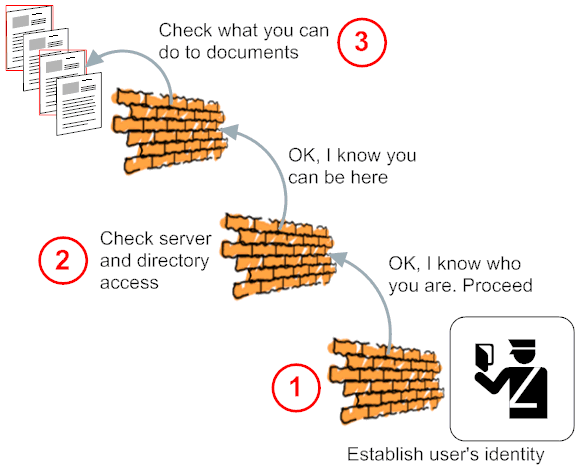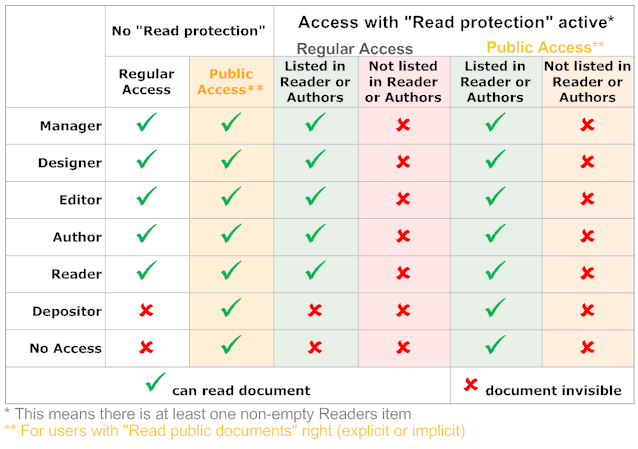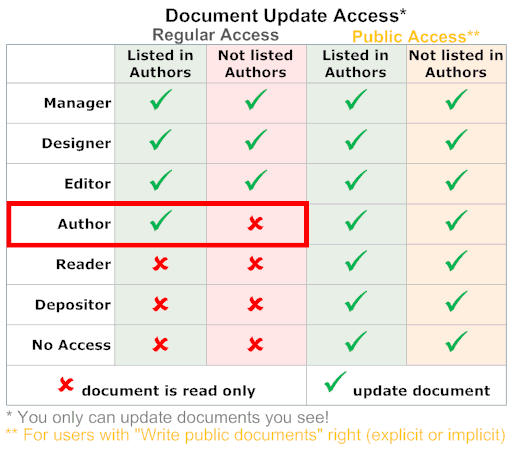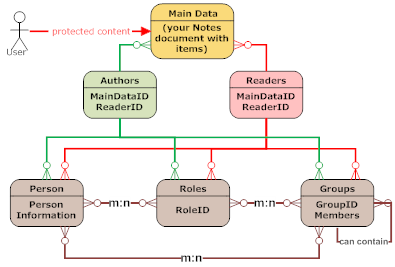Domino Development - Back to Basics - Part 6: Better safe than sorry - Security
Continuing from Part 5, this installment will shed a light on security.
Domino applications are protected by a hirarchical control system. If you fail to pass one hierachy level's test, it doesn't matter if a lower level would be compatible to you current credentials. E.g. when a database would allow anonymous access, but the server is configured to require authentication, you must authenticate. To fully understand the options, sit back and recall the difference between authentication and authorization. The former establishes who you are, the later what you can do. Let's look at both parts:
Accessing Domino through http(s) (or SMTP, IMAP and POP) uses open standards based authentication. I will focus on the http(s) options here. When a resource is protected (more on that later) the user is presented with an authentication challenge. In its simplest form it is http BASIC authentication that prompts for a username and password. In web UIs this isn't en vogue anymore, but in REST based access pulling and pushing JSON or XML it is still quite popular, since it is simple to use.
The most prevalent form (pun intended) is form based authentication. If a protected resource requires higher access than the current known user (who is anonymous before logging in), the user is redirected to a login page, where username and password are requested. This authentication can be per server or for a group of servers using LTPA or 3rd party plug-ins.
Users typically are listed in the Domino Directory or any compatible LDAP directory configured as authentication source. Users on Domino mail need to be in the Domino directory for mail routing to work.
A typical (structural) mistake: trying to use a remote 3rd party LDAP which creates additional network latency and single point of failure (the remote LDAP). When your Domino application server is running, your directory service is available, I wouldn't step away from this robustness. If your users strategically are maintained in a more fragile directory, use TDI to keep them in sync.
The final option to authenticate users is the use of X509 certificates. This requires the public X509 key to reside in the directory and the private key in the user's browser. I haven't seen that in large rollouts since it is a pain to administrate.
Anyway, as a result of an authentication, a user is identified with an X500 compatible name:
CN=Firstname LastName/OU=OrgUnit4/OU=OrgUnit3/OU=OrgUnit2/OU=OrgUnit1/O=Organisation/C=Country
Country (/C) and the Organisation Units (/OU) are optional. Typically we see 1-2 OrgUnits in use. They are practical to distinguish permissions and profiles as well as a remedy for duplicate names. If not taken care of carefully, users authenticated through a 3rd party LDAP will follow LDAP naming conventions, which is a PITA. When
In any case, it is transparent for an application developer on Domino how a user authenticates, you only need to care that it is happening when you protect a resource. Keep in mind: authentication is only secure via https!

It doesn't matter what access a user might have inside a database, if the server won't let the user access its resources. So having your admin locking down the server properly is your first line of defense. Server access is defined in the server document that also contains the ECL for the server. A normal user doesn't need ECL permissions, only the ID that is associated with the XPage (or agent) that a user wants to run. "Associated" here means: the ID the code was signed with. By default every time a developer saves an XPage, that page gets signed with the developer's ID. This is very different from file based application servers where a file doesn't contain a signature, but similar to the JAR signing in the Java world. Keep in mind: in Java that is a manual process using a command line tool and requires the acquisition of an (expensive) code signing certificate, while in Domino it is automatic.
Common practise however is, not to allow a developer to run code on a production server (unless you are Paul), but signing the database with either the server.id or a specific signer ID. This step would be performed by your admin.
When you access an NSF, the access level is set in the ACL to one of these values: No Access, Depositor, Reader, Author, Editor, Designer, Manager.
Additionally a user can have roles assigned to her, that allow a refinement of interaction and access. Roles are always used with the name in square brackets. Typical roles are [server] or [Admin]. Roles are defined per NSF. The following tables shows the permitted operations per access level:
Having read access to a database doesn't automatically make all documents visible. They still can be protected by reader fields. More below
Having Author access to the database does enable a user to edit any document where the user is listed in one or more items of type author, While Editor access allows to edit any document the user can see. So as a rule of thumb:
The access level for normal users to a Notes/Domino based application should be set to Author

Looking at the above table you could conclude: Author fields are only relevant for users with exactly Author access to a database: if the access is lower they won't be able to edit anything, if the access is higher, they can edit anything. However in conjunction with Reader fields they have a second purpose. Reader protection is defined as:
When a document has at least one item of type Readers that has content (non-empty), then access to that document is restricted to users and servers that are explicitly (by name) or implicitly (by group membership, role or wildcard) listed in any of the Reader or Author items.
A typical pattern in a Notes application would be a computed Author field with the value
A popular mechanism is to provide a checkbox "Confidential" and then compute a reader field:
Domino applications are protected by a hirarchical control system. If you fail to pass one hierachy level's test, it doesn't matter if a lower level would be compatible to you current credentials. E.g. when a database would allow anonymous access, but the server is configured to require authentication, you must authenticate. To fully understand the options, sit back and recall the difference between authentication and authorization. The former establishes who you are, the later what you can do. Let's look at both parts:
Authentication
When using a Notes client (including XPiNC) or running a Domino server, the identity is established using a public-private key challenge. The key is stored in the Notes.id file and (usually) protected by a password. So it qualifies as a 2 factor authentication (you need something, you know something). The beauty of this PKI approach is the availability of keys for signatures and encryption. Since users hate password entries you can perform unlocking of the Notes.id using various methods for single signon.Accessing Domino through http(s) (or SMTP, IMAP and POP) uses open standards based authentication. I will focus on the http(s) options here. When a resource is protected (more on that later) the user is presented with an authentication challenge. In its simplest form it is http BASIC authentication that prompts for a username and password. In web UIs this isn't en vogue anymore, but in REST based access pulling and pushing JSON or XML it is still quite popular, since it is simple to use.
The most prevalent form (pun intended) is form based authentication. If a protected resource requires higher access than the current known user (who is anonymous before logging in), the user is redirected to a login page, where username and password are requested. This authentication can be per server or for a group of servers using LTPA or 3rd party plug-ins.
Users typically are listed in the Domino Directory or any compatible LDAP directory configured as authentication source. Users on Domino mail need to be in the Domino directory for mail routing to work.
A typical (structural) mistake: trying to use a remote 3rd party LDAP which creates additional network latency and single point of failure (the remote LDAP). When your Domino application server is running, your directory service is available, I wouldn't step away from this robustness. If your users strategically are maintained in a more fragile directory, use TDI to keep them in sync.
The final option to authenticate users is the use of X509 certificates. This requires the public X509 key to reside in the directory and the private key in the user's browser. I haven't seen that in large rollouts since it is a pain to administrate.
Anyway, as a result of an authentication, a user is identified with an X500 compatible name:
CN=Firstname LastName/OU=OrgUnit4/OU=OrgUnit3/OU=OrgUnit2/OU=OrgUnit1/O=Organisation/C=Country
Country (/C) and the Organisation Units (/OU) are optional. Typically we see 1-2 OrgUnits in use. They are practical to distinguish permissions and profiles as well as a remedy for duplicate names. If not taken care of carefully, users authenticated through a 3rd party LDAP will follow LDAP naming conventions, which is a PITA. When
@UserName() doesn't start with CN= (unless it returns Anonymous) you need to take your admins to task.
In any case, it is transparent for an application developer on Domino how a user authenticates, you only need to care that it is happening when you protect a resource. Keep in mind: authentication is only secure via https!
Authorisation
Now you know who the user is, you define what (s)he can do. Domino uses 2 mechanism: the Access Control List (ACL) to define read/write access levels and the Execution Control List (ECL) to define what code a user can run. The first level of authorization is server access:
It doesn't matter what access a user might have inside a database, if the server won't let the user access its resources. So having your admin locking down the server properly is your first line of defense. Server access is defined in the server document that also contains the ECL for the server. A normal user doesn't need ECL permissions, only the ID that is associated with the XPage (or agent) that a user wants to run. "Associated" here means: the ID the code was signed with. By default every time a developer saves an XPage, that page gets signed with the developer's ID. This is very different from file based application servers where a file doesn't contain a signature, but similar to the JAR signing in the Java world. Keep in mind: in Java that is a manual process using a command line tool and requires the acquisition of an (expensive) code signing certificate, while in Domino it is automatic.
Common practise however is, not to allow a developer to run code on a production server (unless you are Paul), but signing the database with either the server.id or a specific signer ID. This step would be performed by your admin.
When you access an NSF, the access level is set in the ACL to one of these values: No Access, Depositor, Reader, Author, Editor, Designer, Manager.
Additionally a user can have roles assigned to her, that allow a refinement of interaction and access. Roles are always used with the name in square brackets. Typical roles are [server] or [Admin]. Roles are defined per NSF. The following tables shows the permitted operations per access level:
Read Access

Having read access to a database doesn't automatically make all documents visible. They still can be protected by reader fields. More below
Write Access

Having Author access to the database does enable a user to edit any document where the user is listed in one or more items of type author, While Editor access allows to edit any document the user can see. So as a rule of thumb:
The access level for normal users to a Notes/Domino based application should be set to Author
Reader & Author fields
They are quite unique to Domino, since they allow declarative protection of a note. If you implement (in code) something similar in an RDBMS, you get quite a complex relation:
Looking at the above table you could conclude: Author fields are only relevant for users with exactly Author access to a database: if the access is lower they won't be able to edit anything, if the access is higher, they can edit anything. However in conjunction with Reader fields they have a second purpose. Reader protection is defined as:
When a document has at least one item of type Readers that has content (non-empty), then access to that document is restricted to users and servers that are explicitly (by name) or implicitly (by group membership, role or wildcard) listed in any of the Reader or Author items.
A typical pattern in a Notes application would be a computed Author field with the value
[server]. The application server would get the role in the ACL. Since a server most likely has Manager access anyhow, it has initially no impact on the application. However when some mechanism activates reader protection, this field ensures that the server can see all documents. It is important to use an Author field/item here, to avoid triggering read protection where it isn't necessary. Reader fields have a performance cost, so use them wisely.
A popular mechanism is to provide a checkbox "Confidential" and then compute a reader field:
@if(Confidential!="";DocumentPeople;""), where "DocumentPeople" would be an item of type Names. In workflow applications, the content of reader and author fields isn't static, but changes with the progress of the workflow. Careful planning is required.
There is more
Notes can refine access further. Documents can be encrypted and signed, as well as sections in a document can be access controlled or signed. However those capabilities are not yet exposed to the XPages API and are thus of limited interest for new XPages developers.Further readings
There are a number of related articles I wrote over the years:- Access Control in Domino - the Basics
- Access control in Domino - Part 2: Inside your NSF
- Protect your Domino applications from Firesheep
- Workflow and Document Access
- Access protected Notes documents - RDBMS style
- NoReader and NoAuthor Fields
- Reader fields (again) - discussed performance impacts and mitigation
- Reader Fields - extreme Edition (update)
- Reader fields for large user populations (Extreme Edition 2.0)
Posted by Stephan H Wissel on 04 February 2014 | Comments (0) | categories: IBM Notes XPages